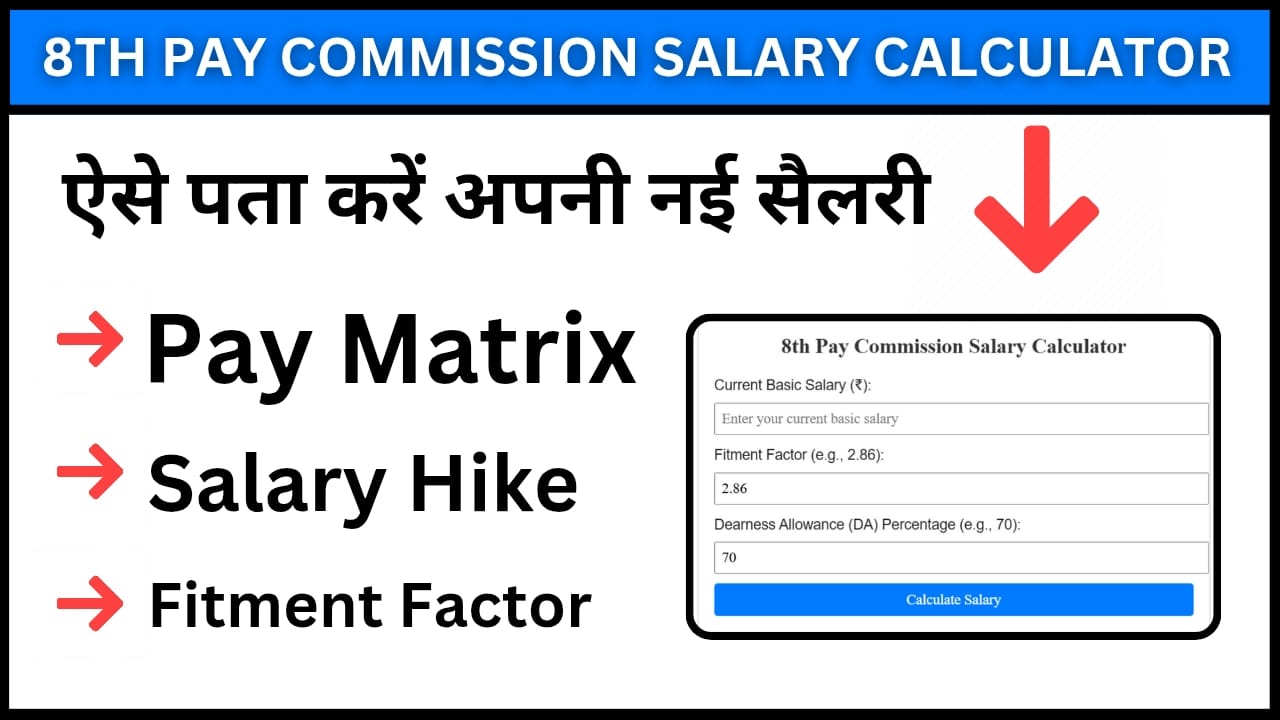The 8th Pay Commission is set to bring significant changes to the salary structure, allowances, pensions, and other benefits of central government employees and pensioners in India. Recently, Prime Minister Narendra Modi’s Union Cabinet approved the constitution of the 8th Pay Commission, which promises a substantial salary hike for central government employees. The implementation of the new recommendations is expected to start in January 2026, following a decade-long interval since the 7th Pay Commission’s guidelines.

In this article, we have discussed detailed insights into the 8th Pay Commission salary hike, fitment factor, pay matrix, and also provided a calculator to check your salary after the implementation.
What is the 8th Pay Commission?
The Pay Commission is an official panel set up by the Union Government of India every 10 years to review and recommend changes to the salaries, pensions, and allowances of central government employees and retirees.
The 8th Pay Commission is expected to:
- Revise the current salary structure introduced by the 7th Pay Commission (implemented on January 1, 2016).
- Bring significant salary increases, allowances, and benefits to improve the quality of life for central government employees.
- Drive higher economic growth through increased disposable income and spending power of employees.
8th Pay Commission Latest News
On January 16, 2025, Prime Minister Narendra Modi announced the approval of the 8th Pay Commission, stating, “The decision will improve the quality of life of government employees and give a boost to consumption.”
- Expected Date of Implementation: January 1, 2026.
- Fitment Factor Increase: From the 7th Pay Commission’s 2.57 times to 2.86 times, with potential performance-based adjustments.
- Minimum Basic Salary Hike: Likely to rise from ₹18,000/month (7th CPC) to ₹26,000/month.
The announcement comes after central government employees’ Dearness Allowance (DA) was recently increased to 53% of their basic pay (effective July 1, 2024).
How Much Salary Hike Can Central Government Employees Expect?
Historical Salary Hikes
In previous Pay Commissions, the increase in minimum basic salaries was significant:
- 6th Pay Commission (2006): Minimum basic pay increased from ₹2,550 to ₹7,000 with a 1.86 fitment factor.
- 7th Pay Commission (2016): Minimum basic pay rose from ₹7,000 to ₹18,000, with a 2.57 fitment factor.
Expected Salary Hike under 8th Pay Commission
Experts predict that the 8th Pay Commission will bring:
- Fitment Factor: Likely to increase from 2.57 to 2.86.
- Minimum Basic Salary: Expected to rise by 186%, from ₹18,000 to ₹26,000 or more.
- Overall Salary Hike: Estimated to be 25-30%, depending on the final recommendations.
Example Calculation (Using Fitment Factor of 2.86):
If an employee’s current basic pay is ₹40,000 (as per the 7th Pay Commission):
- Revised Basic Pay = ₹40,000 × 2.86 = ₹1,14,400/month.
- Excluding Dearness Allowance (DA) and other benefits, this represents a significant increase.
In addition, allowances such as House Rent Allowance (HRA) and Transport Allowance (TA) will also see revisions under the 8th Pay Commission.
8th Pay Commission Salary Calculator
What is the Fitment Factor in the 8th Pay Commission?
The fitment factor is a multiplier used to calculate the revised basic pay of central government employees under a new pay commission.
For example:
- 7th Pay Commission Fitment Factor: 2.57
- Minimum Basic Pay: ₹18,000 (₹7,000 × 2.57)
- 8th Pay Commission Expected Fitment Factor: 2.86
- Minimum Basic Pay: ₹26,000 (₹18,000 × 2.86)
Employees’ overall salaries, including allowances, are adjusted based on this fitment factor, making it one of the most crucial elements of pay revisions.
8th Pay Commission Pay Matrix Table (Expected)
The Pay Matrix provides a simplified structure for salary levels across different government designations. Below is a comparison of the 7th and 8th Pay Commission basic salaries for different levels:
| Pay Level | 7th Pay Commission (Basic Salary) | 8th Pay Commission (Expected Basic Salary) |
|---|---|---|
| Level 1 | ₹18,000 | ₹21,600 |
| Level 2 | ₹19,900 | ₹23,880 |
| Level 3 | ₹21,700 | ₹26,040 |
| Level 4 | ₹25,500 | ₹30,600 |
| Level 5 | ₹29,200 | ₹35,040 |
| Level 6 | ₹35,400 | ₹42,480 |
| Level 7 | ₹44,900 | ₹53,880 |
| Level 8 | ₹47,600 | ₹57,120 |
| Level 9 | ₹53,100 | ₹63,720 |
| Level 10 | ₹56,100 | ₹67,320 |
The vertical progression in the pay matrix ensures annual increments, while the horizontal levels indicate functional roles across government departments.
How Will the 8th Pay Commission Impact Central Government Employees?
- Salary Increases:
Employees can expect a 25-30% hike in basic pay and proportional increases in other allowances. - Enhanced Allowances and Benefits:
- Dearness Allowance (DA): Likely to increase further based on inflation levels.
- Pensions: Retirees will see enhanced pensions and EPF benefits.
- Gratuity: Higher gratuity payouts due to increased salary levels.
- Economic Impact:
With higher disposable incomes, central government employees will boost domestic consumption, contributing to India’s GDP growth.
Expected Timeline for the 8th Pay Commission
| Approval of 8th Pay Commission | January 2025 |
| Formation of Pay Commission Panel | July 2025 (tentative) |
| Implementation of New Pay Scale | January 1, 2026 |

Aman is a tech enthusiast with a strong interest in emerging technologies like artificial intelligence, machine learning, and digital transformation. A graduate of Sri Venkateswara College, Delhi University, he is passionate about how technology can reshape industries and improve lives. While Aman prefers to keep his personal life private and doesn’t like revealing much about himself, his work speaks for him. At SAMSA, he serves as a Moderator, ensuring the accuracy of facts, reviewing technical details, and collaborating with the team to enhance content quality. His keen eye for detail and deep understanding of tech help create insightful and reliable articles.


